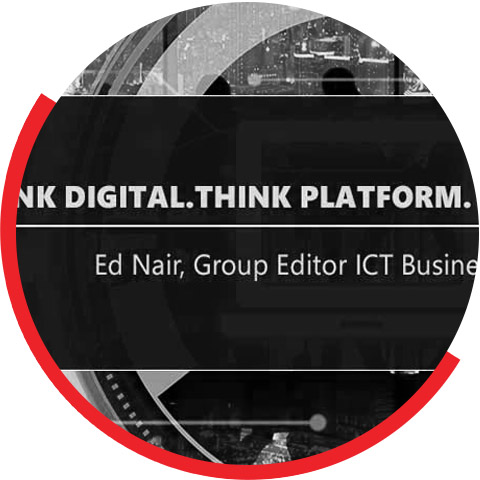The set of 'born digital' companies such as Uber, Amazon, AirBnB, Alibaba have provided lessons in digital disruption to the rest of the world. We live in the digital world where market disrupters are developing platforms that facilitate exchange between the customers and makers, partners or even peers, reshaping industries into interconnected ecosystems.
Digital disruption makes scale inconsequential, it turns assets into liabilities or at best makes them irrelevant, it turns customer loyals into infidels, it upturns every value equation on its head. These are truths that we have seen play out in the last few years.
The Complexities of Digital Transformation

Digital transformation is a complex process; it is an urgent and inescapable journey but without a clear roadmap or definite destination. But a recent Tech Pro Research survey reveals that only 20% of survey respondents said they have a formal digital transformation plan in place, another 60% said they were actively developing one. This means that a majority of organizations are still grappling with their digital transformation roadmap.
With the escalating pressure to adopt digital strategies comes the need to develop a thorough understanding of what the transformation entails, along with its benefits, pitfalls, and how well it's succeeding (or not) for other organizations and industries.

Despite the money spent and resources allocated toward digital transformation, most efforts are seeing abysmal levels of success. According to the report by Couchbase, 90% of digital projects fail to meet the expectations set before them, and are only bringing "incremental improvements." All this is increasing the pressure on IT leaders to continually improve customer experience and productivity at their organizations. There's also money on the line in the future, states the Couchbase report, which reveals that 87% of IT leaders were concerned that their revenues would drop if they couldn't improve the customer experience—the core goal of digital transformation as defined by the respondents.
Born Digital Companies and Platforms
The starting point for digital transformation is to look at what makes 'born digital' companies pathbreaking and successful. Born digital companies adopt a platform-based business model fostering an ecosystem that's most conducive for end-to-end business traction in a hyper-connected world.
What is a platform-based business? Here's the definition: "A business based on enabling value creating interactions between external producers and consumers. The platform provides an open, participative infrastructure for these interactions and sets governance conditions for them."
Platforms are revolutionizing the way we do business. Traditional business models are linear in structure with inputs at one end and output at the other. Unlike the linear mode of generating and consuming value in the pipe model, platforms serve as an ecosystem of value generation and consumption. They create value by tapping into resources that they don't need to own.
The shift from the linear, resource-heavy, producer driven pipe model to a demand-driven, circular networked model is enabling four big outcomes for enterprises – flexibility, scalability, mobility, and availability, through the collaboration of diverse participants.
Platforms— Core Design Principles
Platforms, especially in the digital world, have been powered by a set of technologies such as social, mobility, analytics, cloud, IoT, AR/VR, and artificial intelligence amongst others. Of these, the first four— social, mobility, analytics, and cloud— are popularly referred to as the SMAC stack. When SMAC is compounded with other underlying technology approaches such as PaaS environments, micro-services, DevOps, and automation, true platform based systems can be built.

These technologies yield the basic construct of platforms: three essential stacked layers of infrastructure comprising cloud, networking, applications, content, and APIs; the network layer that facilitates value exchange through social media, marketplaces, and other ecosystems; the data layer comprising analytics, AI, and other refinements; and the enveloping layer of access comprising mobile devices, IoT, AR/VR, and other edge devices.
These layers must be designed to yield the performance characteristics of a platform. According to an HBR article, by building a digital platform, other businesses can easily connect their business with yours, build products and services on top of it, and co-create value. This ability to plug-and-play is a defining characteristic of 'platform thinking'. Further, the success of a platform strategy is determined by three factors:
A. Connection: How easily others can plug into the platform to share and transact
B. Gravity: How well the platform attracts participants, both producers and consumers
C. Flow: How well the platform fosters the exchange and co-creation of value
Platforms are not just stacks of technology layers. Platforms require design thinking as opposed to systems thinking.
The differentiating design principles of a platform could be summarized as:
- Designed to leverage 'Intelligence' by capturing data and re-populate the platform and gain massive insights.
- Designed as 'Open Networks' enabling a seamlessly connect with the key stakeholders- customers, vendors, etc.
- Designed as highly 'Networked Systems' that facilitates them to be hyper-connected
- Finally, by virtue of the above 3 elements, designed to build a 'scale as you grow model' and be relevant to the market demands.

Sonata Software's thought-leading proposition to apply these principles to accelerate the adoption of digital platforms to result in digital transformation is called platformation. Through various global engagements, Sonata has been able to demonstrate and unlock value by implementing the platformation framework to achieve the successful execution of digital transformation projects across various industries.
Platformation— Under the Hood
We said that platforms are not just stacks of technology layers. That said, building digital platforms requires bringing together various technology platforms and ecosystems together.
According to Gartner, a digital business is supported by technology platforms in five areas:
- Information systems platform — Supports the back office and operations, such as ERP and core systems.
- Customer experience platform — Contains the main customer-facing elements, such as customer and citizen portals, multichannel commerce and customer apps.
- Data and analytics platform — Contains information management and analytical capabilities. Data management programs and analytical applications fuel data-driven decision making, and algorithms automate discovery and action.
- IoT platform — Connects physical assets for monitoring, optimization, control, and monetization. Capabilities include connectivity, analytics and integration to core and OT systems.
- Ecosystems platform — Supports the creation of, and connection to, external ecosystems, marketplaces, and communities. API management, control and security are its main elements.
Together with best practices and domain IP in various verticals, Sonata's platformation framework/methodology incorporates the above concepts along with the design principles of digital platforms. This helps enterprises navigate digital transformation challenges and accelerate digital transformation outcomes.
Digital platforms built using the Platformation framework embodies and delivers the following capabilities and functionalities.
- The technology environment, application build approach, and the IT operations model work together as one system and to a very different rhythm.
- Integrated stacks to common standards on the cloud in a highly secure environment, with auto-scaling is the norm for infra.
- Applications are designed as micro-services, with multi-device and channel-reach capability, with Big Data, AI, IoT, and Telemetry-enabled functionalities for intelligent contextual transactions which can be easily integrated and orchestrated within this standard environment.
- Operations approaches include full automation with continuous development, integration, and deployment capability for fast, flexible feature releases, as well as in-built operations analytics that help platform self-learning that measure, control, and optimize system performance.
Platformation— Deployment Approaches and Engagement Models

Sonata's track record of engineering SaaS & PaaS systems for leading ISVs, serving digital transformation needs of Fortune 500 enterprises using platforms, and the investments made in building and operating its own mission-critical platforms to support industry-leading businesses underpins its capabilities to deliver platformation.
Platformation is delivered through a set of two skillsets that are at the core of Sonata's capabilities: engineering excellence and operations excellence.
- Engineering Excellence is built on Sonata's product engineering mind-set, distributed agile & rapid delivery tools, and own IP assets in DevOps and Automation areas. Operations Excellence adds value – built on Sonata's ability to design cost-optimized cloud operations, tool-based operations management suite, and its extended security compliance & business continuity services.
In terms of execution approaches for Platformation, Sonata has identified three paths to delivery:
- Deploying industry-specific digital business platforms— An end-to-end business platform approach through industry-specific cloud platforms-
- Deploying industry standard horizontal platforms with added functionality— Popular horizontal platforms on leading ISV stacks that a business is already invested into, can be deployed if time, cost, and risks need to be moderated in going platform, especially with specific business process areas.
Engineering custom digital platforms that are scalable— A very unique set of business features and the willingness to invest time and money in setting up a differentiated platform may mandate an approach where a significant part of the platform is custom-built.
Differentiating features include:
- Sonata Ready — is a platformation approach meant to maximize the speed of your digital agenda with Sonata's pre-built, end-to-end, industry-specific platform solutions. Rezopia is the Sonata platform for digital travel, Brick & Click is a retail industry platform, and the Modern Distribution Platform is Sonata's industry solution for the supply chain and distribution needs of retail, consumer, and industrial goods companies. These solutions come with pre-integrated omnichannel commerce, mobility, analytics, and ERP and pre-built, best in class, industry segment-specific business functionalities that can be deployed on cloud and adopted as the core of a fully refreshed digital IT backbone.
- Case Study: — Successfully deployed the Rezopia platform for an Australia based Rail Network, which deployed an omni-channel booking backbone cutting across the web, physical counters and call center.
- Sonata Accelerate — is an approach that leverages leading ISV platforms such as Microsoft Dynamics 365, Microsoft Cortana Intelligence, and SAP Hybris omnichannel commerce platforms for digitization. Sonata consultants assess, implement, and support, these platforms to help build and deploy specific digital business processes. This route is used to leverage compatibility with existing stacks and to be ready to leverage further enhancements that these ISVs will make to their platforms in the times ahead.
- Case Study: — A US-based fashion brand successfully leveraged the Dynamics platform and created a seamless omnichannel experience.
- Sonata Custom — is the approach where customers can leverage platform engineering skills to create a custom-built platform that is scalable. Uses platform engineering skills in Digital, Agile, DevOps, and CloudOps, Sonata's IP-led frameworks and methodologies to build platforms that are highly customized to specific business needs and functionalities. This approach also enables businesses to limit their licensing costs even as they scale as they own the IP. Sonata also white-labels its proprietary industry and technology platforms when needed, to boost the speed of custom development programs.
- Case Study: — A US-based travel company innovated on membership-based business models, increasing bookings by 200%, and scaling service 6X to 120,000+ members.
Sonata has established customer-specific centers of excellence (CCoE) in governance and value co-creation with a charter to enhance domain and technical knowledge, knowledge management, innovation, process and capability, and reusability.
3 Phase Customer Value Model
Sonata has also invested in the future through acquisitions that are accretive to the Platformation value proposition. Sonata's acquisition of Interactive Business Systems Inc (IBIS) a supply chain platform running on Dynamics AX solution; Rezopia- a cloud-based travel industry platform; and Halosys an enterprise mobility platform— these acquisitions in conjunction with Platformation act as accelerators for digital transformation.
Platformation— 'Real'izing Digital Transformation
Platformation ushers in true digital capability and transforms the traditional enterprises to operate like 'born digital' companies like Amazon, Netflix and the host of 'click' companies which have created a very successful digital business in a very short span of time. Sonata's Platformation approach for digital transformation clearly unravels the digital transformation complexities and takes on a systematic approach to building digital platforms.
Many a digital transformation project fails to deliver despite the copious use of modern technology components. In an interview with Dataquest, Sangeet Paul Choudary, one of the leading experts in platforms theory in the world said, "A lot of executives see digital transformation as ticking the boxes on setting up a digital presence. It completely misses the point, you are just changing the interface from physical to digital. Instead, digital transformation involves a fundamental redesign of the business model. It is important to pursue digital transformation with a clear architecture of what the digitally transformed business should look like."
This means that digital transformation requires rigor, both in business design and in technology architecture. Add to that the need for speed. Sonata believes that the right digital transformation partner should have the combination of industry-specific domain expertise, platform thinking approach, engineering skills, IP-led frameworks and solutions, industry-ready platforms and accelerators, and powerful engagement models. Sonata's Platformation approach has delivered on these fronts.
Lastly, innovation is deeply tied to people and culture. Says Srikar Reddy, Managing Director, Sonata Software, "Our value proposition lies in the breadth of platforms we offer, our deep industry expertise, quality and processes, proven platformation record, deep client commitment, and global reach. The key to our success so far has been our team, whom we have nurtured with regular exposure to newer technologies, evolving business scenarios, cross-functional expertise, and continuous exposure to clients to assess the business impact of solutions delivered and design thinking as a core approach to execute on platformation. Our flexible working style encourages ideation within broad boundaries and we embrace and promote innovation and agility with deep-rooted corporate values."











